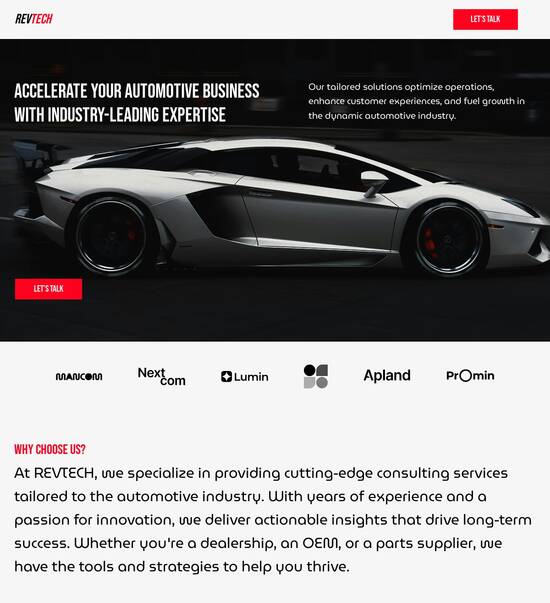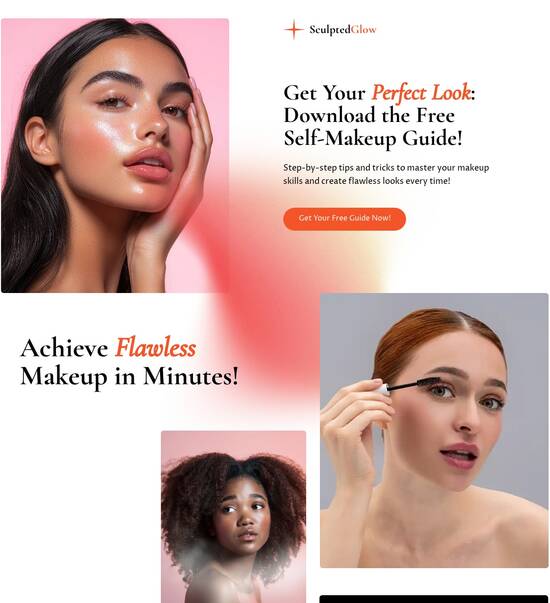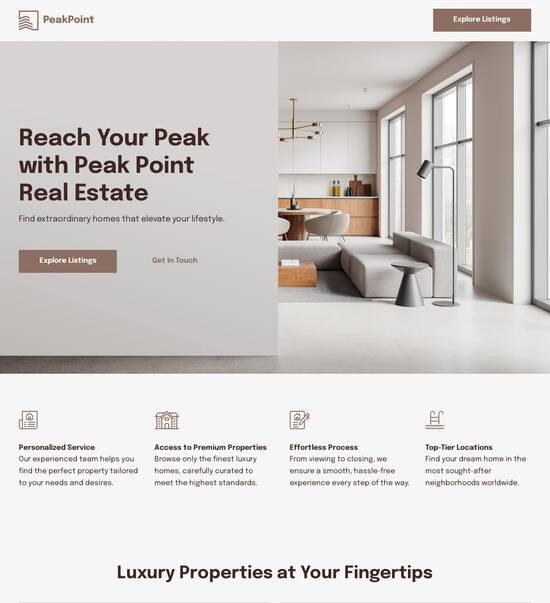
One page website template for art galleries
Explore Similar TemplatesAbout template
Jumpstart your one page website with our polished, ready-to-go template for art galleries.
Recommended templates

Easy to build without coding
With the intuitive drag-and-drop builder, anyone on your team can create high-converting pages without any knowledge of code or design. Make enhancements to your landing page with custom widgets using Javascript, HTML/CSS, or third-party scripts.

Multiple layouts for any industry and goal
Select from 500+ landing page layouts built to boost conversions across industry-specific scenarios. Customize them by adjusting fonts, adding images, and generating on-brand content with the AI assistant. Quickly scale with Instablocks® and Global Blocks that you can save, reuse, and update globally.

Loads fast and looks polished on any device
Every template is responsive, which means they present professionally on any device and load blazingly fast with our Thor Render Engine. You can also power them up with Google AMP technology to deliver an unparalleled mobile experience and drive higher conversions.

Robust analytics & experimentation
Get real-time updates and reporting across all your devices, showing the number of visitors, conversions, cost-per-visitor, and cost-per-lead. Launch AI-powered experiments, run A/B tests, and use heatmaps to analyze user behavior, then optimize your landing page to maximize conversions.







Easy to build without coding
With the intuitive drag-and-drop builder, anyone on your team can create high-converting pages without any knowledge of code or design. Make enhancements to your landing page with custom widgets using Javascript, HTML/CSS, or third-party scripts.
Multiple layouts for any industry and goal
Select from 500+ landing page layouts built to boost conversions across industry-specific scenarios. Customize them by adjusting fonts, adding images, and generating on-brand content with the AI assistant. Quickly scale with Instablocks® and Global Blocks that you can save, reuse, and update globally.
Loads fast and looks polished on any device
Every template is responsive, which means they present professionally on any device and load blazingly fast with our Thor Render Engine.
Robust analytics & experimentation
Get real-time updates and reporting across all your devices, showing the number of visitors, conversions, cost-per-visitor, and cost-per-lead. Launch AI-powered experiments, run A/B tests, and use heatmaps to analyze user behavior, then optimize your landing page to maximize conversions.
All the features you need to build lead-generating landing pages
Explore more featuresLearn how to build top-performing landing pages for any goal
FAQs
Leading the way in building high-performing landing pages





Mastering landing page optimization with Instapage
In digital marketing, effective landing page optimization can significantly elevate campaign performance. Instapage offers industry-leading tools that are designed to empower marketers to leverage user-friendly templates, robust analytics, and seamless collaboration features. This guide outlines actionable steps to optimize your landing pages effectively and maximize your ROI.
Understanding the fundamentals of landing pages
A landing page serves as a standalone web page designed specifically for a marketing or advertising campaign. Unlike typical web pages, landing pages are focused and tailored to convert visitors into leads or customers. With Instapage, you gain access to over 100 customizable templates that allow for quick creation and deployment, which caters to the specific needs of various industries, such as business services, education, and financial services.
- High-converting templates: Instapage provides more than 100 pre-built templates optimized for conversions, allowing marketers to easily create visually appealing landing pages.
- Lead generation elements: Built-in lead gen tools help capture visitor information seamlessly, boosting overall engagement and conversion rates.
- Customization: The flexibility of drag-and-drop builders means that no coding skills are required, making it easy for even non-technical users to craft landing pages that meet their needs.
Step 1: Crafting your landing page strategy
The first step towards effective landing page optimization is to define your goals. Whether you're aiming to increase sign-ups, gather leads, or drive product sales, your objectives will inform the design and layout of your landing page.
Step 2: Utilize optimization tools for better performance
By leveraging Instapage's optimization tools, you can enhance the effectiveness of your landing pages. Here’s how to effectively utilize these features:
- A/B testing: Instapage allows users to run A/B tests seamlessly to determine the most effective variations of content, headlines, and layouts.
- Detailed analytics: The built-in analytics dashboard provides actionable insights about visitor behavior, helping you make informed decisions to enhance performance.
- Heatmaps: Utilize heatmaps to visualize user interactions on your landing page, allowing for data-driven refinements.
Step 3: Personalizing user experiences
Creating personalized experiences can significantly increase the likelihood of conversions. Instapage enables dynamic text replacement and audience-specific content delivery. Tailoring your landing pages to audience segments will reinforce engagement and boost conversion rates.
- Dynamic content: Automatically adjust page content based on visitor behavior and characteristics to enhance relevance.
- AdMap features: Align specific ads with corresponding landing pages for a cohesive user journey, enhancing the overall marketing impact.
- Engagement tracking: Monitor how different segments of your audience interact with your content to refine your personalization strategies.
Maximizing your landing page potential involves continual refinement and adaptation based on user feedback and analytics-driven insights.
Start leveraging Instapage today to streamline your landing page creation process, maximize conversions, and accelerate your campaign performance. Sign up now to explore the powerful features designed to elevate your marketing strategy.
One page website template for art galleries
The art of simplicity: Understanding one page website templates
One page website templates for art galleries stand out due to their straightforward design, allowing galleries to showcase their artworks without the clutter often associated with multi-page layouts. Unlike traditional websites that require users to navigate through various pages to view content, one page designs condense all essential information into a single scrolling page. This not only improves user experience but also enhances focus on the artwork itself, making it particularly effective for art galleries.
The appeal of one page layouts lies in their simplicity. By eliminating unnecessary navigation and repeatedly exposing viewers to the same engaging content, these templates allow galleries to deliver a powerful visual narrative. This approach proves especially effective for art galleries, enabling viewers to immerse themselves in the aesthetic experience rather than getting lost in a web of links and clicks.
The aesthetic advantage: A focused design approach
Minimalist design plays a crucial role in the effectiveness of one page website templates for art galleries. A clean, unadorned layout allows the featured artwork to take center stage, eliminating distractions that might deter viewers. This style resonates well in the art community, where the focus must remain on the pieces of art, fostering an environment conducive to appreciation and contemplation.
In implementing a one page website, specific design elements enhance the visual storytelling process. High-quality images, sufficient whitespace, and strategic placements of elements contribute to an immersive experience. Utilizing these components thoughtfully can make artwork come alive, guiding visitors through a curated journey that reflects the gallery's vision.
Features of one page website templates for art galleries
When exploring one page website templates crafted for art galleries, tailored layout options emerge as a critical feature. Layout choices, such as grid versus list formats, can substantially impact user experience. A grid layout can offer a visually striking display of artworks, allowing multiple pieces to be showcased simultaneously. In contrast, a list layout may provide a sequential flow, guiding users through each artwork with attention to detail.
Ultimately, the choice of layout should align with the gallery's branding and the story it seeks to tell. This alignment can make navigating the website a more engaging and harmonious experience.
Grid layouts: Perfect for showcasing multiple artworks at once, often seen as more formal.
List layouts: Provide a more narrative approach, highlighting individual pieces in context.
Portfolio showcase capabilities
Effective display of artwork is key in any art gallery website. The focus on image quality and sizing cannot be overstated; high-resolution images allow art enthusiasts to appreciate the nuances of each piece, while improper sizing can distort the viewer's experience. Templates that enable artists to present their works in high-quality formats help to maintain the integrity of the artwork and engage viewers effectively.
Additionally, categorization plays a pivotal role in optimizing user engagement. Art can be categorized by medium, theme, or even artist, allowing users to navigate more effortlessly through the collection. Such functionalities can enhance the overall experience, making it easier for visitors to discover and explore artworks that resonate with them.
Custom color schemes and typography
Color schemes and typography greatly influence the overall feel of an art gallery's website. Choosing a color palette that complements the artist’s style or the theme of the artwork can elevate the visual appeal. Neutral backgrounds can serve as a perfect backdrop for vibrant pieces, while a consistent color story can tie the entire website together, making it more aesthetically pleasing.
Similarly, typography influences perception and emotional responses. A carefully chosen font can amplify the message being conveyed through the art, whether it be a modern sans serif that emphasizes contemporary pieces or an elegant serif that enhances traditional artworks. Opting for readable, yet expressive fonts will ensure that text complements rather than competes with the visual narrative of the gallery.
Empowering artists: Built-in functionalities
SEO-friendly templates serve as invaluable tools for enhancing online visibility. In a world where viewers often rely on search engines to discover art, optimizing the content within these templates for search engines becomes essential. Key features include meta tags, alt text for images, and structured data, all of which can significantly boost the gallery's presence online.
Moreover, the incorporation of sound effects and media templates can enrich the user's browsing experience. Subtle soundscapes can transport a viewer into a gallery-like atmosphere, while multimedia elements—such as videos showcasing the artist's process—can offer a deeper understanding of the creative journey. These functionalities promote engagement and retention, turning a simple website visit into a more immersive experience.
SEO features: Enhance discoverability through optimized content.
Integration of soundscapes: Create an immersive gallery experience.
Utilization of multimedia: Provide insight into the artist's creative process.
Responsive design for access anywhere
In our increasingly mobile-first world, ensuring that art gallery websites are responsive is no longer optional. A responsive design guarantees that the website adjusts seamlessly across various devices, from desktops to smartphones, providing an optimal view regardless of screen size. This adaptability not only increases accessibility for potential art enthusiasts but also encourages prolonged engagement by making the viewing experience more comfortable.
The effects of responsive design on user engagement are profound. Statistics show that mobile users are more likely to abandon websites that do not display properly. By prioritizing responsive design, art galleries can significantly enhance their online presence and capture the interest of a broader audience, ultimately leading to increased visibility and potential sales.
The user experience: Navigating an artful journey
User experience plays a critical role in the effectiveness of one page designs. One of the primary considerations is navigation; seamless scrolling versus clicking options can dictate the proactive nature of user interactions. While scroll-based designs allow for fluid transitions between sections, some users may prefer hitting traditional menu items. Thus, choosing between a sticky menu or smooth scrolling must align with the gallery's target demographic.
Pros and cons exist for both approaches. A sticky menu allows instant access to any section, while smooth scrolling can create a more immersive, cinematic experience that feels continuous. Ultimately, the most effective option will depend on the content being showcased and the preferences of the audience.
Scroll-based navigation: Offers fluid transitions for an engaging experience.
Sticky menus: Provide quick access to various sections, enhancing convenience.
Engagement features: Capturing viewer attention
Incorporating animated elements and hover effects enrich the overall user experience. Subtle animations can lead visitors into the site, guiding them effortlessly from one captivating section to another while fostering a sense of intrigue. Hover effects serve to create interactive moments that engage users and invite them to explore more deeply by revealing additional information or expanding images.
In addition, utilizing callouts and pop-ups can spotlight special exhibits or upcoming events. These features draw immediate attention to important announcements, ensuring that visitors can stay informed about the latest happenings in the gallery world. However, it's crucial to strike a balance; overusing pop-ups can frustrate visitors instead of enticing them, so they should be deployed strategically.
Boosting online presence: Marketing strategies for art galleries
Landing page templates are instrumental in boosting online presence and driving traffic to the main gallery site. By creating distinct landing pages for exhibitions or special events, galleries can attract targeted visitors eager to learn more. These pages serve as a focal point, detailing all relevant information in a straightforward manner, prompting action and engagement.
Moreover, incorporating a blog into a one page template expands opportunities for engagement. Blogs can provide behind-the-scenes insights, artist interviews, and event recaps, allowing visitors to connect with the gallery on a personal level. This connection can foster loyalty, making repeat visits more likely as audiences develop a deeper appreciation for the art and the story behind it.
Landing pages: Drive traffic and showcase specific events effectively.
Integrating a blog: Enhances engagement with informative and relatable content.
Selecting the right template: Tips for art galleries
When selecting a one page website template, galleries must evaluate their needs carefully, striking a balance between function and style. Different types of galleries may have unique requirements based on their artistic focus, ranging from traditional exhibitions to modern art spaces. Understanding these requirements is essential to prevent future frustration with functionality that does not serve the gallery’s goals.
Furthermore, comparisons between free and premium templates can help in making a more informed choice. While free options may suffice for small galleries or emerging artists, premium templates often come with additional features and customization options that can better suit larger institutions or established artists.
Evaluate needs: Consider artistic focus and required functionalities.
Compare options: Weigh the pros and cons between free and premium templates.
Showcasing creativity: Examples of successful one page art websites
Studying case studies of successful artist websites provides invaluable insights. Notable examples of one page templates can reveal effective design choices, user engagement strategies, and overall effectiveness. Analyzing these sites can uncover best practices that galleries can tailor to their unique artistic narratives.
Additionally, startup agencies often lead the charge in redefining how art is presented online. Innovative examples that push the boundaries of traditional art gallery websites not only inspire creativity but can also prompt galleries to consider modern approaches to displaying art in the digital realm. Transformative ideas such as integrating social media feeds or user-generated content can offer fresh perspectives.
Case studies: Analyze successful artist websites for best practices.
Inspiration from agencies: Explore innovative practices redefining art presentation.
Future trends in one page art gallery websites
The role of AI in personalizing user experiences on one page sites is becoming increasingly significant. Emerging technologies facilitate tailor-made experiences that can engage visitors like never before. AI-driven templates can learn user preferences and dynamically adapt the site's content, making each visit more relevant and enjoyable.
Moreover, e-commerce integration within art gallery templates represents a trend that cannot be overlooked. Selling art online is becoming a necessity, and templates that accommodate this shift can enhance the traditional gallery model, reaching a broader audience and increasing revenue opportunities. Through seamless e-commerce integrations, art galleries can facilitate transactions, allowing art lovers to purchase pieces from the comfort of their homes.
AI personalization: Tailor content to enhance user experiences.
E-commerce integrations: Revolutionize the way art is sold online.
Ready to skyrocket conversions?
Supercharge your ad campaigns with high-performing landing pages
Get started














